The Marquesas Islands
Okay, this is a long, long blog entry about our recent trip to the Marquesas Islands.
The Marquesas Islands. Officially the world’s most isolated island group (thanks, Wikipedia). The nearest continent is North America, some 5500 kilometres away. A few tiny volcanic dots in the vast blue immensity of the Pacific Ocean. Distant, remote, rugged, cut-off. After visiting London and Paris over the last two years, the Marquesas were an obvious destination for our next sojourn.
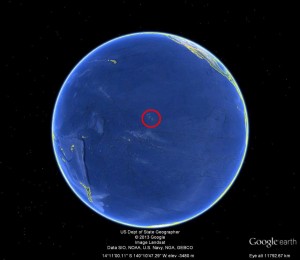
The desire to visit the remote Marquesas Islands was prompted by spotting a tiny advertisement in the Melbourne Age some years ago. It resonated with me as I’ve always been attracted to the notion of the South Seas through reading things such as Ballantyne’s Coral Island, works by Joseph Conrad, Robert Louis Stephenson and Jack London. Wendy and I have already visited Vanuatu and Fiji, but the vastness of the Pacific beckoned.
Just about the only way to visit this far off archipelago is via the Aranui, a hybrid cargo/passenger ship that is almost the only way the Marquesans get supplies. The Aranui makes 17 voyages a year and without the cross-subsiding that the passengers bring, the Marquesans would be even more cut off than they are.
After talking about it in vague terms for years we finally nailed our colours to the mast and booked. A seven and a half hour flight to Tahiti impressed us enough with the distances involved, but we knew that after we boarded the Aranui in Papeete harbour, it was another 1400 kilometres before we’d reach the Marquesas Islands. The Pacific is very, very big.
We had a couple of days in Papeete while the Aranui was loading, and we enjoyed this enchanted place. Tahiti is one of the hubs of Polynesian life and has all the Mutiny on the Bounty/Captain Cook Transit of Venus/Tropical Island Paradise thing going on. And it’s all true. Colours, fragrances, warm winds and astonishing vistas are everywhere.
Papeete is the capital of the immense territory of French Polynesia that also includes the Marquesas. The official language is French, and French culture and ways mingle with the Polynesian to make a unique tropical European blend.
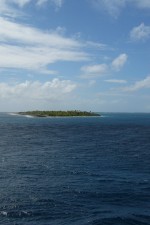
We boarded the Aranui for our 13 night voyage (note: not a three hour tour) and left Papeete for our first destination – Fakarava.
Fakarava is one of the atolls of the Tuamoto chain, a third of the way between Tahiti and the Marquesas. Atoll – low, flat, a thin ring of land with an astonishing lagoon inside and the brutal ocean on the outside. Atolls are almost the cliché tropical island, with nodding coconut palms, white sand and the improbable blue of the lagoon. Fakarava was a largish atoll, maybe a few hundred metres across at its widest, and it was gorgeous. When the Aranui eased through the narrow gap in the atoll and docked, the crew went into cargo unloading mode, using cranes to swing containers, crates and sundries onto land, we were able to spend the morning wandering about and then snorkelling. Delightful – but we had to be back on ship in time for it to leave on schedule. Warning blasts of the ship’s horn reminded everyone that this is no luxury cruise.
The Aranui has a maximum of 190 passengers. The front half of the ship is all set up for cargo and the back for passengers – but while the accommodations and appointments are comfortable there are no casinos, cinemas or spas. The food is good – extremely good – and the bar is well set up, but there is no diverting the ship for sightseeing or jolly tourist jaunts. The passengers have to fit in with the cargo delivery schedule. While the ship is in port, loading and unloading, we did have plenty of organised excursions to villages, archaeological sites and points of interest, but this all works within the arrangements for keeping these islands supplied.
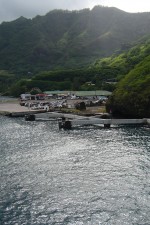
After Fakarava, we had a night, a whole day, and another night totally at sea as we made our way to the Marquesas Islands. The weather was benign, but the swell was enough to cause a distinct diminishing of numbers in the restaurant. I had come equipped with heavy duty sea sickness medication as I assumed I’d be a land lubber enough to go green as soon as I lost sight of land, but I surprised myself by being unaffected. I actually enjoyed the swooping, rocking motion of the ship as we ploughed along with nothing to see in any direction except more ocean.
Our first Marquesan landfall was on the largest island in the chain, Nuku Hiva. The first sight of our destination was arresting. I knew something about the Marquesas through researching beforehand, but the reality was stunning. Huge, ragged mountains encircled the bay we entered, a landscape so unlike rounded and weather worn Australia. The scenery is all the more dramatic for the lush tropical greenery set against the forbidding rock spires whose immensity is emphasised by being so close to sea level. The highest point on Nuku Hiva is some 1200 metres and all around the clouds are caught in the volcanic upthrust.
We docked in Taiohae, the largest town on Nuku Hiva and the administrative centre of the Marquesas. It’s a pretty little place, 1500 people or so. We spent all day here, first hopping in 4WDs and visiting an archaeological site with its stone platforms, communal areas and carved tikis. Lunch was a Polynesian feast in the town, straight out of the underground oven, with lots of red bananas, breadfruit, taro, pork, fish and goat. Delicious. Then we went on a hike uphill to a viewing point over the bay. This turned into a slog when it rained, turning the track into a muddy water channel. Then we re-joined the 4WDs and were taken on a winding journey over the hills to Taipivai, the valley where Herman Melville lived for a month in 1842. Some exploration, some sightseeing, then it was back across the mountains in the trusty 4WD to board the Aranui in Taiohae, ready to sail to our next destination.
The Aranui left Nuku Hiva and sailed overnight for Ua Pou, arriving early. We woke to the sounds of hectic unloading in the town of Hakahau. The cranes were in full swing at 6 am, heaving trucks, containers, cars and cargo of all sorts to the dockside. Lots of whirring and clanging and shouting, much activity and much jollity. The arrival of the Aranui is always greeted with enthusiasm.
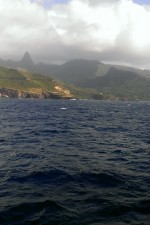
The Hakahau handicrafts market was open with lots of carvings and jewellery and a wedding feast was being prepared on the beach
side. We walked around the tiny town, admiring the plants and gardens, then popped back to the ship for a break before going back into the town for lunch. This was fun. A dance and music show beforehand, then lots of Polynesian delicacies – breadfruit, banana, taro, beef, pork, seafood. Good sauces and seasonings, this was excellent.
In the afternoon we went back to the ship as it loaded up and then it went 11 kilometres down the coast to Hakahetau. The coastline was staggering – sharp, craggy, many pillars and caves, the landscape was jaw-dropping. All the islands are remarkable in their profile, but Oa Pou is probably the most remarkable. It has a true enchanted island outlook with improbable rock spires launching into the almost omnipresent cloud layer, while the sea crashes against cliffs that plunge into the depths. These are no gentle tropical islands – they are mostly harsh and grim, unexpectedly opening out into tiny enclaves of tropical lushness cloistered around tiny bays surrounded by beetling ridges. The contrast is breath-taking.
It’s fairy tale stuff.
Hakahetau was just a cargo stop – no time for us layabouts to land.
Another overnight journey took us to the island of Hiva Oa where we woke early again (6 am) in the bay of Puamau with much activity ferrying cargo via the barges to the tiny wharf in rather bouncy seas. We breakfasted and then were handed by the muscly crew into the barges to get across. This was a precarious exercise at both ends and full of potential disaster, but the crew was stolid. The barge going up and down a few metres? Seen that before. Eighty year old passenger with walking sticks? Yawn, try something hard. Giant spindly killer fish leaping out to
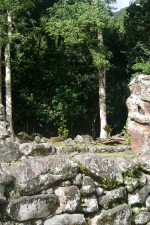
attack the tourists? Okay, I made that one up, but the crew members were wonderful in making sure we embarked and disembarked safely.
We were ported into 4WDs to another archaeological site underneath an imposing massif. Lots of carvings, tikis and platforms, after which we walked back down the gentle slope to a plantation. This was a wonderful place where they gave us lots of fresh fruit (grapefruit and bananas to die for) and they sold handcrafted pareos, plus noni juice (medicinal taste but I’m now proof against all known illnesses and disease) and fresh vanilla! We bought lots of fresh, fragrant vanilla beans, something I’d been looking forward to. Tahitian vanilla is special, different from other vanilla, and is particularly prized. It has a subtle almost aniseed undertaste, melding with all the usual warm, redolent, rich vanillaness. It’s swooningly good.
When we reached the beach we had time for a swim and it was marvellous. The surf was boisterous but safe and the water was warm and inviting. Back on board the good old Aranui and we chugged around the coast some 10 K to Haniapa where we did the disembarking thing again and simply walked through a tiny townlet, quiet and sleepy, with many lovely well tended gardens. The whole valley is nicknamed the Valley of Citrus, and indeed we saw many lime, pomelo and grapefruit trees, but also noni, grapefruit, breadfruit and vanilla.
Day Six and more Hiva Oa. This time we woke up when the Aranui was unloading in Atuona, the biggest town on the island. We were docked, so no barge transfer, but it was chaos on shore with forklifts, people, trucks, dogs, chickens, cars and children milling about.
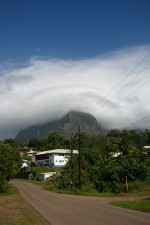
Wendy and I opted to walk from the dock into town, which took us about an hour or so and we saw stupendous views of the harbour and the neighbourhood along the way. The peak Temetiu claws up 1,200 over the town. Clouds were crowning it as we neared; it seemed to be making its own weather.
When we got to the town centre we went to the bank, inspected handicrafts at the display in the town centre, then we visited the Gaugin centre and then the Jacques Brel display. These two Europeans both died here and both have contributed to the islands legend as the paradise at the end of the world. Then we sat on the beach and enjoyed the breeze and the view as the heat was stifling. Lunch was fun, another Polynesian feat with bananas, plantains, breadfruit, but good pork, goat and fish. Lots of hilarity.
The afternoon was back on board as it went to Tahuata, a nearby island, and unloaded cargo via barge. No shore time for us.
The French Regional Commissioner apparently came on board in Atuona as part of a regional tour, causing great interest, especially from some of the French passengers. He and his party (including bodyguard!) stayed with us for a number of stops, a goodwill tour of this most remote part of his bailiwick.
Day Seven brought us to Fatu Hiva. This is the southernmost and most isolated of the main islands of the Marquesas, and also the wettest. We had a couple of pretty drenching showers while were there, but nothing too toward. It’s the youngest of the islands, so its landscape is possibly the spectacular.
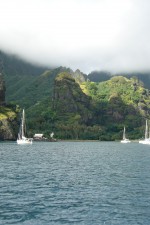
Morning was a visit to the village of Omoa, at the end of another dramatic bay encircled by saw-toothed mountains. The village itself was neat and picturesque. We visited a tiny museum in what was an old planter/merchant’s house – two storeys, islander build. It was evocative of how the better off lived and recalled Conrad, Maugham and London. Lots of handicrafts for sale and we had a lovely demonstration of tapa (bark cloth) making and also the making of perfumed garlands using a huge variety of spices, roots, leaves and flowers.
After a short trip around the island, the afternoon was a visit to a tiny village at the end of a tiny bay – Hanavave on the Bay of Virgins, probably the most stunning site we’ve seen so far – and that’s saying something. Huge pillars of rock, cliffs looming over the town and bay, clefts in solid stone. This is landscape utterly unlike any I’ve seen before, and the way it all plunges down into the sea while being cloaked in tropical greenery is astounding.
The village was quiet until the dancing welcome brought everyone out and then it was like market day with the warmest of welcomes.
I found out later that because of the cliffs and ridges around the town, it doesn’t get much sunlight at all. Only when the sun is low in the west, and then the place is washed with golden light and the shadows lift, briefly, before the rapid sunset.
There’s a story in that detail alone.
Day Eight brought us back to the island of Tahuata, where we’d previously delivered cargo but not landed. The morning found us anchored in the bay off the town of Vaitahu. We barged to shore and were greeted by locals, one with a huge pet pig. Most towns greeted us with flowers and leis, but the garlands were particularly beautiful and fragrant here. A small village, with the cliffs more distant than some we’ve seen, but it was very friendly and welcoming. We visited a small museum, full of archaeology recovered by teams over the last twenty years or so. The lead archaeologists were there and charmingly answered questions about Polynesian history.
The handicrafts market was busy – the island specialises in exquisite bone carving – and then we visited an impressive Catholic church. The day was blue and gentle, no wind to speak of, unlike many of our other days.
Back to the ship, then we nipped up the coast a little to a beach for a BBQ lunch. The beach was a unusual one for the Marquesas, with good golden sand. It was still steep and prone to powerful waves, but the conditions were gentle. Good food, lovely location, fun swimming.
After dinner we had a presentation by the Romanian ship’s chief engineer. He spoke three languages, translating on the run, and the whole presentation was informative about the workings of the ship, and wonderfully eccentric.
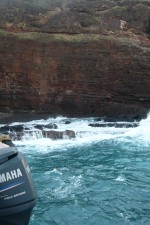
Day Nine was a 4 a.m. start as we approached Vaipaee Bay, Ua-Huka. This ‘invisible bay’ is too small for the Aranui to enter, turn around and exit, so it anchors just outside the narrow chokepoint and then turns 180 degrees on its anchor while two whaleboats roar off to attach lines to the nearby cliffs. This whole manoeuvre is extremely tight, with only metres between either end of the ship and rocks/cliffs. All the passengers lined the rails to take photos and cheer on the crew.
Breakfast after this and then barging to Vaipaee town. We were treated to dancing, a cultural museum and handicrafts, then we went via 4WD to the nearby botanical gardens. Stephen, our guide, showed us many edible fruits and their trees. Delightful. We were then taken on a stunning scenic coastal road through Hane village to Hokatu, with its handicraft centre and petroglyph museum. Then back to Hane for a Polynesian lunch at Chez Celine Fournier restaurant. Great bananas.
After this it was a walk to a lovely beach and then, because Hane has no dock, the whaleboat passage back to the ship. This is completely different from the usual barging, more the old-fashioned way. We had to wade into surf (shepherded by the willing crew) and then prop and swivel via the transom into the whaleboat while waves crashed around us. I was in the bow so I took the brunt of the waves with courage and self-sacrifice. I was soaked, but it didn’t matter. Tropical seas and all that.
When we reached the Aranui, though, the swell made disembarking quite hair-raising, with the whale boat rising and dropping perilously. The crew earned their money here and we didn’t lose anyone that I heard of.
Later, it was the big Polynesian Night. Feast, plus show – Wendy’s dance group put on a series of dances which they’d been rehearsing every day. They were sensational.
Day Ten. Our last day in the Marquesas. Once again, the Aranui docked in Taiohae Bay, Nuku Hiva, nice and early, and being docked meant no hair-raising barge transfers. It was to be a quick stop in this second visit to Taiohae, really just so the Aranui could pick up empty containers that had been unloaded since our previous visit. Wendy and I walked in to the town, about half an hour, then a quick look around at the beach
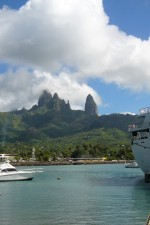
front, the archaeological site of Temehea and the largest Catholic church in the Marquesas.
We farewelled Nuku Hiva and lunched on board while the Aranui sailed to the island of Ua Pou where we docked in Hakahau and had free time. Wendy perused the handicrafts and then we had a swim in the warm, gentle waters of the bay near the Aranui. Local kids came up to us, all playful, full of questions, teasing and well-natured.
Back on board, we sat at the bow and watched the rock cathedral of Ua Pou fall behind us, our last glimpse of this mysterious, fascinating, improbable island group.
Day Eleven was another day at sea, restful after some of our recent exertions. Reading, gazing out at the sea, talking in a desultory manner, eating the superb meals. Pleasant.
Day Twelve brought us to the Tuamotos again, this time to Rangiroa. We went through the gap in this huge atoll (second biggest in the world) at around 8.30, then we pulled up to a dock. After breakfast we were barged from the dock to a barbecue site half a kilometre away on the beach. The day was quite grey and overcast to begin with, but gradually broke up and patches of blue sky exerted themselves.
After establishing ourselves on the beach (and seeing three reef sharks cruising along in the shallow water) we went for a scheduled visit to a pearl farm. Some good explanations and demonstrations of the process, and the shop had some stunning jewellery. Black pearls are magical.
After a beachside barbecue and some snorkelling, we boarded the Aranui again. The ship made a majestic turn and then headed through the gap in the atoll accompanied by dolphins.
After a night’s smooth sailing, we arrived early back in Papeete. If you have to have come back to somewhere that signals the end of an extraordinary journey, then Tahiti isn’t a bad place to do it. We had a day in Papeete and flew home early the next morning.
So what were the best things about the trip? So many highlights … The otherworldly scenery, the Polynesian culture, the feeling of being at the end of the world, the shipboard life, the warm and wonderful crew, meeting and spending time with so many kind and interesting people – Ross and Bernadette, Alice and Genevieve, Ian and Carmel, Trixie and Mike, Lorna and Stephen, Pauline and Lionel, Nancy and Huw, Scout and Joshua, Tricia and Roger, Jurgen and Gail, John, Nick, Sue and others – and the exotic splendour of the South Seas.
So many arresting sights, so much remarkable history, so much strangeness. It’s not a trip for everyone, but if something out of the ordinary appeals, then investigate the Aranui and its workings.
Thanks Michael, makes me want to visit too.
Hi Andrew! It’s a pretty amazing trip, all right and highly recommended for anyone who wants something out of the ordinary, but still with some mod cons.
Well done to condense all that travel/sightseeing into a very readable, chatty excursion. That’s how I like my travel; hearing about what others have done! I guess I was born without a spirit of adventure or a travel gene.
Great review! Those who may not know, the 320 passenger ship Paul Gauguin also makes trips to the Marquesas multiple times a year. On your ship aren’t the excursions included in the cost?
Yes, the Aranui cost includes all island excursions, apart from a few optional diversions (sports fishing, glass-bottom boat at Rangiroa).
I actually saw the Paul Gauguin in Papeete harbour and it looked very sleek indeed!